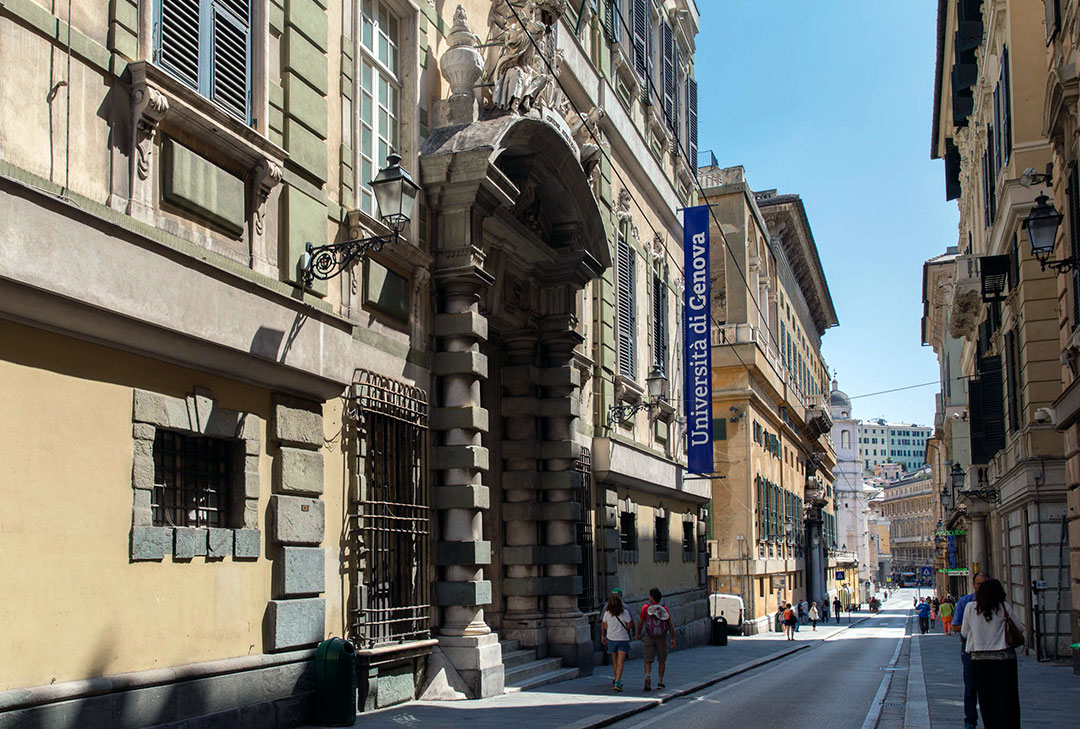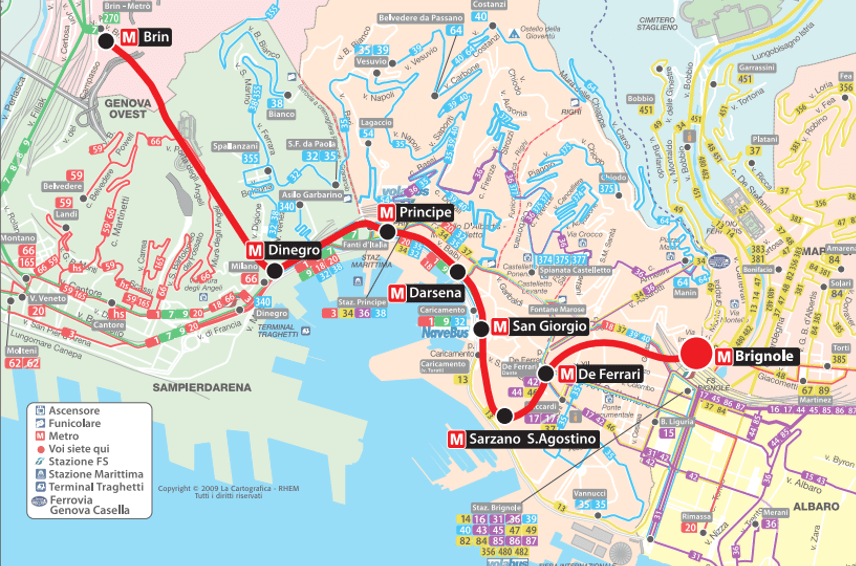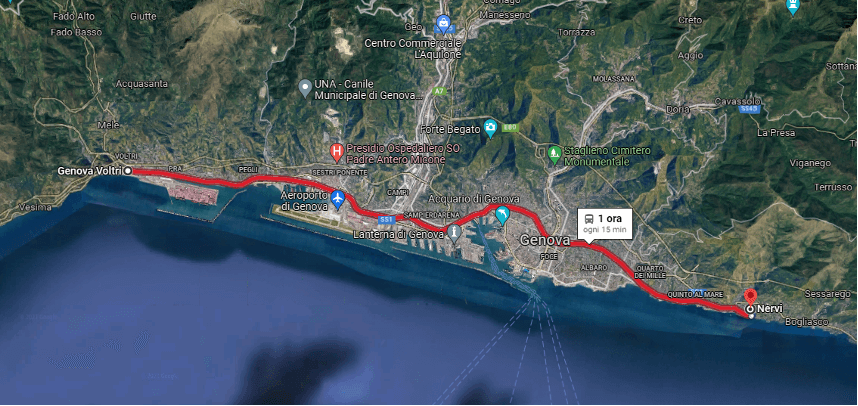Green Mobility Guide
Genoa
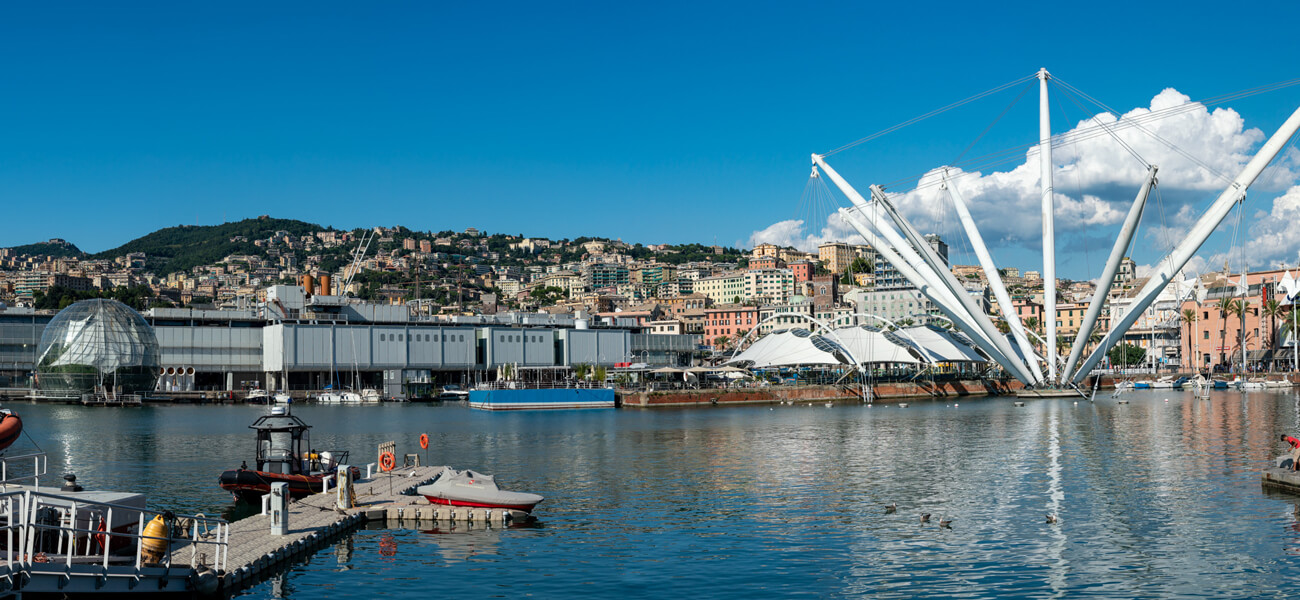
When we consider moving around Genova in a sustainable way, there are many possibilities. We may group into three categories:
- Slow individual mobility (walking or riding personal bikes)
- Public Transport
- Sharing mobility (scooters, bike or car sharing)
As Genova climate conditions result relatively mild in every month of the year, walking and biking are favourable alternatives to move around the city.
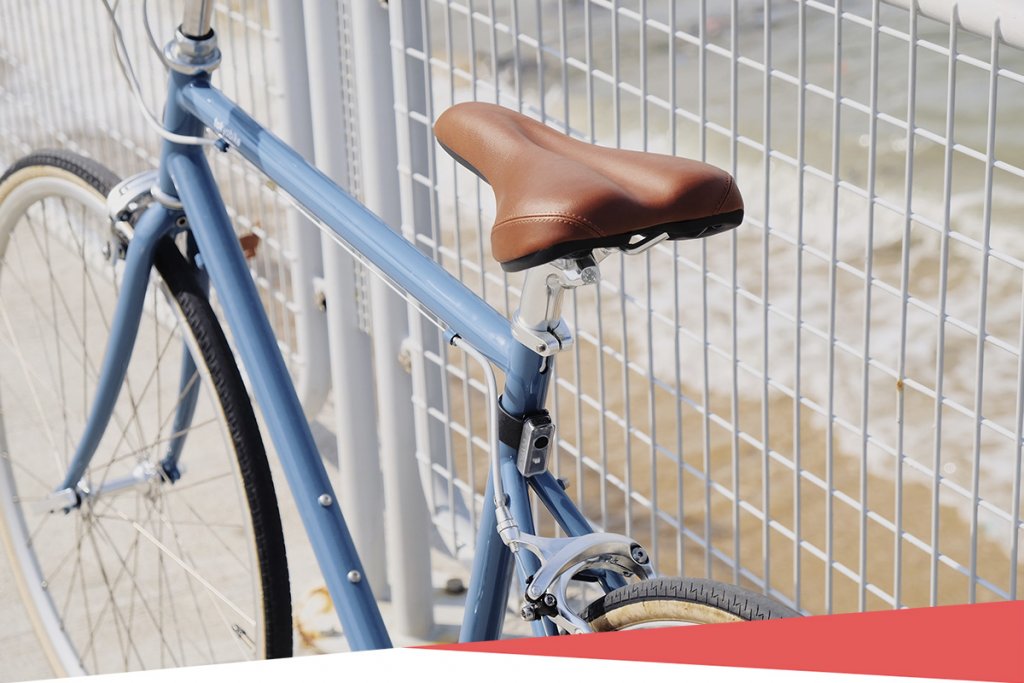
Most of the historical centre of Genova is completely car-free and many other pedestrian areas are located in the city centre. It is possible to walk to reach university buildings, main cultural and public institutions, shops, supermarkets, restaurants, etc. It is easy to move around Genova when distances are relatively short.
Biking around Genova is a good choice, too. Although historically its steep streets have always discouraged people from using bikes for everyday mobility, a new environmental consciousness and, recently, the Covid-19 outbreak has boosted the development of new bike lanes.
Gradually “emergency lanes”-that where built temporarily at the beginning of the pandemic-are now converted into permanent ones, and urban network is expanding from the city centre to the peripherical neighbourhoods along the coast and towards inner suburbs.
UniGe itself is contributing to this growth of the urban bike network through dedicated lanes design in order to make University accessibility simpler for those that choose to reach it by bicycle.
Bus network and urban railway are the most used options, being the first very widespread in the urban centre and the second one the main alternative for commuters.
Subway is also very used by people that need to move fast across the city centre; even though there aren’t many stops, they’re located in the main hubs of Genoese core area.
Tips & Recommendations
Underground / Subway
General information
Genova has a Metro line, too, that runs across its central area. At the present moment, there are 8 stops connecting the railway hubs with some of the main spots of the historical centre-that are relevant from a turist, cultural and functional point of view (Economics and Architecture Faculties, Cruise and Ferry Terminals, the Aquarium…) and the densely populated area of the Val Polcevera, a narrow valley in the western part of the city. Even though the metro line is only 7 km long, it provides a fast (it has an 8 minutes frequency) and efficient service to many city users (commuters, school and university students…)
Name of the company
AMT
Website
Ticket prices
- €2.00 (100 minutes-valid for urban bus network, metro line, public elevators and cable railways)
- €2.20 (100 minutes-valid for urban bus network, urban railway, metro line, public elevators and cable railways)
Student prices and/or seasonal tickets
Student prices are available only for annual subscriptions valid for urban bus network, urban railway, metro line, public elevators and cable railways. Prices are €255 instead of €395 for 14-25 users and free annual ticket for University Freshmen.
Urban rail (short distance train)
Genova is a linear city that runs along the coast for almost 30 km and the railway connects different neighbourhoods from the Eastern to the Western points of the city. Urban trains route is approximately 1 hr long (train leaves every 15 minutes) and there are thirteen urban stations along this line. Genova Piazza Principe and Genova Brignole are the city centre railway hubs and they’re located respectively on the Western and Eastern side of the urban centre.
Name of the company
Trenitalia
Website
Ticket prices
- €2 urban rides
- €2.20 (100 minutes-valid for urban railway, urban bus network, metro line, public elevators and cable railways)
Student prices and/or seasonal tickets
Student prices are available only for annual subscriptions valid for urban bus network, urban railway, metro line, public elevators and cable railways. Prices are €255 instead of €395 for 14-25 users and free annual ticket for University Freshmen.
Bus
Bus urban network is made up by 140 lines and more than 2500 stops. This widespread service runs along the coast, reaches inner areas through the main valleys (Val Polcevera and Val Bisagno) and climbs upon the hills behind the city. Even though the urban centre attracts the majority of bus routes, this network enables city users to move around the whole municipality, from the historical core to the remotest parts.
Name of the company
AMT
Website
–
Ticket prices
- €2 (100 minutes-valid for urban bus network, metro line, public elevators and cable railways)
- €2.20 (100 minutes-valid for urban bus network, urban railway, metro line, public elevators and cable railways
Student prices and/or seasonal tickets
Student prices are available only for annual subscriptions valid for urban bus network, urban railway, metro line, public elevators and cable railways. Prices are €255 instead of €395 for 14-25 users and free annual ticket for University Freshmen.

Ferry
The Western part of the city has a maritime link, too, to the city centre: the so- called Navebus. The trip is half an hour long and this ferry represents a panoramic and relaxing alternative to cross the urban area. Four rides a day are provided in each direction.
Elevators
Verticality is one of the main features of Genova urban area, so that in the previous century 15 elevators were build in order to improve accessibility and make reaching the highest neighbourhoods easier. Even though nowadays it’s easier to travel and move around the city, elevators are still present and useful for city users. Most of them are located immediately behind the urban centre while some of them are present along the Bisagno Valley (one of the most densely populated and steep areas) and in Western neighbourhoods where “verticality” prevails:
- Castelletto Levante
- Castelletto Ponente
- Castello D’Albertis-Montegalletto
- Ponte Monumentale
- Piazza Manin
- Quezzi
- Cantore-Scassi
- Magenta-Crocco
- Via Mura degli Angeli
- Via Montello
- Via Bari
- Borgo Incrociati-Corso Montegrappa
- Via Puccini
- Bolzaneto
Cable railways
Cable railways are present, too. There are three lines that climb the hills behind the city centre: Principe-Granarolo; Zecca-Righi; and Sant’Anna.
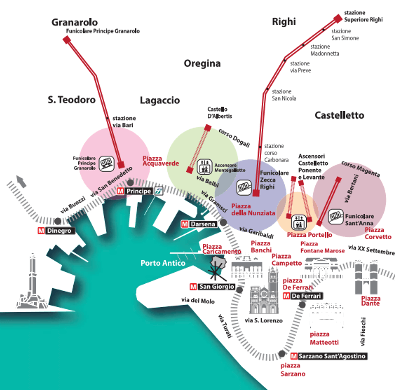
Public bicycle rentals
There is a bike-sharing service that provides several stations across the city centre.
ZenabyBike
It’s a station-based bike-sharing by Genova Parcheggi. All the operations (registration, unlocking, paying, etc..) are available on the app Weelo.
See below the breakdown of prices:
- One day €15.00 (all inclusive)
- 3 days €30.00 (all inclusive)
- Annual €40.00
It’s a station-based bike-sharing by Genova Parcheggi. All the operations (registration, unlocking, paying, etc..) are available on the app. Main stations are located inside the city centre:
- Matitone
- Principe Railway Station
- Piazza Caricamento
- Piazza DeFerrari
- Via XX Settembre
- Brignole Railway Station
Other cycling options
Sharing Mobility can represent one the principal solutions in order to move around Genova in a seamless and customized way thus reducing environmental travel impacts. This reduction works twice: sharing vehicles means less cars moving around the city, that leads to softer traffic conditions and lower polluting emissions; but even the vehicles themselves are green, too.
Scooters and cars used for these services are fully electric thus combining flexibility, customization and sustainability.
Carpooling
- BlaBla Car
- Elettra Car-Sharing
- Elettra is a mixed car-sharing service by
- Duferco. There are 44 cars in free-floating mode and 45 station-based vehicles.
Free-floating mode is active in the urban centre, and you can track online (or using the app) real-time the closest cars and check their charge level.Car sharing stations are located on the entire extension of the municipality, from the city centre to peripherical areas. Registration, reservation and unlocking operations can be made online or via app.
- Sustainable citizens is an association made up of young adults and some students) who are very active and headed by an UniGe colleague. On their site there is also a sustainable advice section which has several things, including the map of green shops around the city of Genoa.
- Recycling, there is this relevant action by municipality and on how to sort your recycling.
- Separate Collection.
- Drinking water fountains in some buildings and distribution of water bottles to freshmen and staff.
- Students’ Association.
- Agenda 2030 training Course.
Sustainable mobility represents one the main strategical goals for UniGe community. That’s why University of Genova promotes several initiatives to reduce transport-related environmental impacts and polluting emissions (transport is nowadays one of the most critical and strong-impact sectors) and to support sustainable and healthy lifestyles.
First step was to design and approve a specifically designed planning tool, the so-called Piano Spostamenti Casa-Università (Home-University Travel Plan). This plan, according to Italian laws, sets the framework to implement further initiatives to support sustainable mobility and reduce transport-related externalities.
The idea is basically to identify a bundle of actions to support gradually students’ and employees’ modal shift towards slow, public and shared mobility, in order to decrease private car use.
UniGe Travel Plan actions focus on the following axes:
- To define incentives and reductions for PT subscriptions;
- To design a new bike lanes network to connect PT stations and University buildings and simultaneously to define several new bike parking areas in these locations;
- To introduce discounted rates for full-electric urban car-sharing service;
- To support awareness-building and communication initiatives on sustainable mobility alternatives.
In addition to the UniGe Travel Plan initiative, University of Genova took several actions to enhance and promote sustainable mobility among its community.
First of all, as previously mentioned, an agreement was signed with the company which is responsible for the urban full-electric car-sharing service (energy power comes from renewable sources) to introduce discounted rates for students and employees from UniGe. An agreement was signed with PT company, as well to make subscriptions cheaper for both students and workers (freshmen were granted a free annual PT subscription). Particular attention was paid to the implementation of communication and dissemination activities in order to engage students’ community in the initiatives towards a massive modal shift.
According to this, it can be really interesting to refer to two UniGe activities that took place recently.
UniWeLab Hackathon
Dated September 2021 and podcast production on green mobility topics. UniWeLab Hackathon initiative consisted of a two-days contest for students and PhD candidates from several courses (from engineering and architecture, economic and communication studies, as well) to produce a short podcast on sustainable mobility and the regeneration of a local infrastructure. This contest was hosted by UniWeLab a joint lab by UniGe and a leader company in the infrastructure sector.
Podcast production
Though, is not a totally novelty for UniGe students as in the recent years professors from many courses introduced audio and video formats as a new learning tool. One of the most significant experiences was in fact the creation of green mobility podcasts by urban planning students in order to develop creative and innovative ideas and to design green solutions to sustain modal shift and support urban sustainable mobility strategies.
Free PT subscriptions for freshmen students
Since 2021/2022 academic year, UniGE is offering free public transport subscription (subscription reduction are already available for young people under26) in order to enhance sustainable mobility and life-style among those who are entering University courses;
University bike lanes network
As previously mentioned, biking is not very popular among University students, most of them are commuters and even those who live nearer don’t choose this option very often. In order to improve bike accessibility and safety for students and employees, UniGE is working (together with Genova Municipality) on the project to create dedicated bike lanes, connecting existing network to most of the University locations. This is undoubtedly a win-win strategy: urban network is growing for every city users and UniGE community gains an easier way to move sustainably
PRINCE Project
Co-financed by Italian Environment Ministry, has the main goal to promote modal-shift towards sustainable mobility for university students through specifical subsidies and rewarding system. An initial phase of the project concerned surveys among students in order to investigate their mobility routines. Currently UniGE is implementing rewarding initiatives such as discount for sharing-mobility, UniGE provides several discount policies in order to boost sharing mobility among students and employees. Scooter-sharing and car-sharing services are available at smaller prices for UniGe community members.
Welcome Guide
The University of Genoa, known also with the acronym UniGe is one of the largest universities in Italy. It is located in the city of Genoa and regional Metropolitan City of Genoa, on the Italian Riviera in the Liguria region of northwestern Italy. The original university was founded in 1481.
The University of Genoa has high-ranking positions among the European universities in multiple computer science fields: in machine learning and pattern recognition the University of Genoa is the best scientific institution in Italy and is ranked 36th in Europe; in computer vision the University of Genoa is the best scientific institution in Italy and is ranked 34th in Europe; in computer graphics the University of Genoa is ranked 2nd institution in Italy and 35th in Europe. The University of Genoa has a strong collaboration with the Italian Institute of Technology (IIT), since its foundation in 2005.
